Schedule a Demo
In the journey of building a powerful online presence, businesses are often at a crossroads: opt for a tailor-made custom design or a ready-to-use template? Each path has its merits and challenges, and making an informed decision requires understanding what each offers.
I've witnessed the transformation that custom software can bring to enterprises. Crafted specifically to your business's needs, a custom-designed website embodies your brand's identity, creating a unique user experience. This bespoke approach allows for endless scalability, seamless integration with existing systems, and, arguably most important, a competitive edge. From my collaborations with business leaders, I've seen how bespoke solutions enable a level of innovation and customization that templates simply can't match.
In terms of functionality, a custom site can include advanced features such as personalized user dashboards, sophisticated e-commerce solutions, or intricate data analysis tools. These are particularly beneficial for large organizations needing internal tools or customer portals where performance and specific functionality are crucial. Furthermore, having a website that perfectly aligns with your operational model means you aren't just showing up online—you're enhancing your operations and customer engagement, which directly correlates to business performance.
Templates, on the other hand, are the quick and often cost-effective solution. They've revolutionized website building by allowing even the most budget-conscious startups to establish an online presence rapidly. However, it's not just about the cost savings. Templates are frequently developed by teams who understand current design trends, ensuring your site remains contemporary without hiring a dedicated design team.
Furthermore, templates come with the advantage of built-in features and functionalities that are plug-and-play. This means you can swiftly launch a website with a structure and tools in place that might take a custom development team much longer to build from the ground up. And for many companies, the immediate online presence these templates afford is a strategic asset in itself.
But there's a flipside to template usage. When addressing a high-level audience, it's worth noting that using a template can sometimes undermine a brand's distinct identity. Many other businesses may use the same template, leading to a sameness that erodes the opportunity to stand out. This conformity can be particularly stark in competitive sectors where individuality is key.
Beyond aesthetics, the restrictions on customization mean that scaling or modifying a templated site to meet advanced enterprise needs can become a tangled and costly process. Integrations may not be seamless, and when you need to adapt rapidly to market shifts or internal demands, a templated site may slow you down. These points are crucial for decision-makers who expect their digital tools to evolve alongside their business strategy.
The investment in custom development goes beyond the initial financial outlay. It's an investment in long-term brand differentiation, advanced functionalities, and an optimized user experience, all key concerns for the discerning executive. In contrast, the immediate, often lower upfront costs of templates can appear attractive, but what's the lifetime cost, factoring in potential overhauls and the limitations on brand and operational value?
For some businesses, however, templates can serve as an interim solution, allowing time to save or earn more revenue, eventually investing in a more tailored approach. This approach may suit companies in the rapid growth phase or those transitioning into a new market, where a quick online presence is more valuable than a long-term detailed design.
From my discussions with IT security heads and website performance experts, there's a notable difference in these domains between custom and templated solutions. Custom-developed sites often have a more robust security foundation as they can incorporate specific security protocols from the ground up, minimizing vulnerabilities that templates might introduce through ubiquitous use. And in terms of performance, which can be especially critical for high-traffic customer portals, custom solutions can be fine-tuned to maximize efficiency and speed.
The decision between custom design and templates is not binary; it's a spectrum. As a manager or executive in a large organization, you're tasked with discerning which approach best serves your current and future operational needs. Could a template provide a satisfactory baseline with room to transition to custom later, or does your business model necessitate starting with custom to satisfy unique operational efficiencies and customer experiences?
In my experience advising companies across various sectors, the capacity to evolve digitally must be at the forefront of any decision-making. A scalable solution fits the evolving needs of large organizations best. Is the initial investment in custom work offset by the potential increased returns from having a digital presence that is crafted exactly for your business?
It's also worth considering the broader picture of what your website needs to achieve. Is it about branding and establishing a unique market position, which might favor a custom approach? Or is it about swiftly getting online at a manageable cost—a context in which templates might suffice? The key question for executive decision-makers should be, "What does success look like for our enterprise's digital presence, and which route best navigates us there?"
When we talk about website solutions for enterprises, we must acknowledge that every business's needs are as unique as their market propositions. To assist in your decision, consulting with technology leaders such as those at Forrester Research Forrester can offer valuable external insights on the best strategies tailored to your specific industry and business objectives.
Ultimately, technology is both an investment and a tool for business growth. The right approach to website design is that which aligns with your company's mission, culture, and digital strategy. While weighing your options, keep in mind that the chosen path should support—and not hinder—your organization's ability to adapt, grow, and stand out in a crowded digital marketplace.
